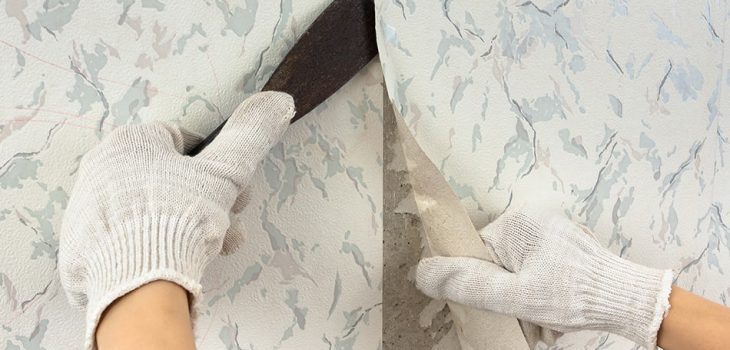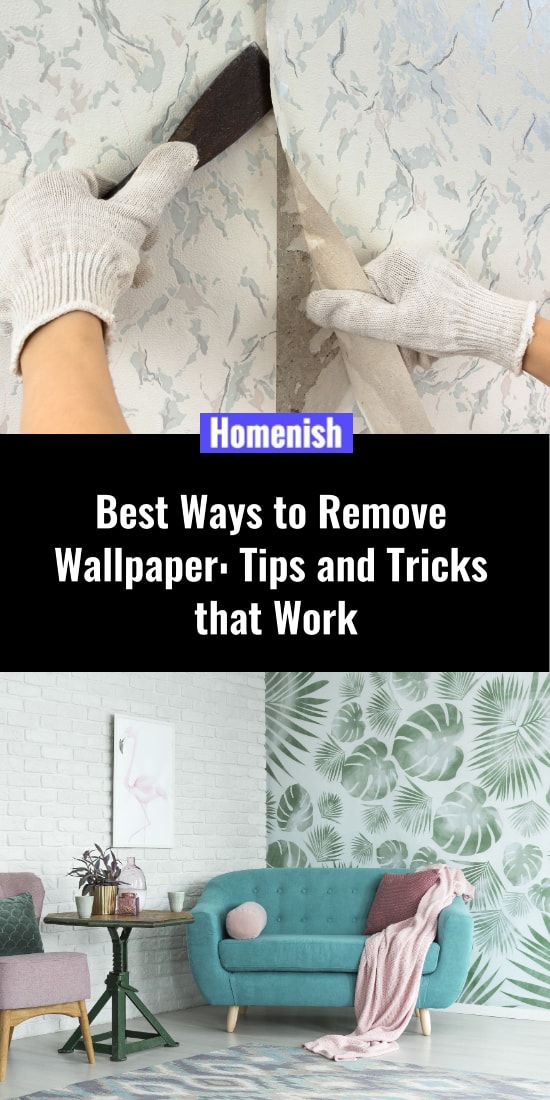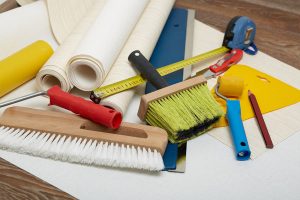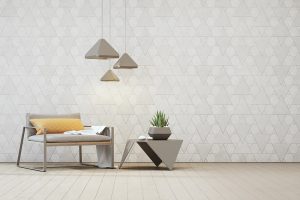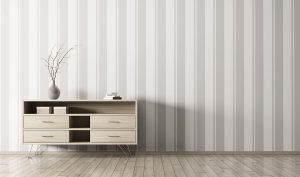Removing wallpaper is a messy and time-consuming task. Unfortunately, there are no shortcuts, but with the right tools, anyone can remove their old wallpaper.
Some techniques work better than others, depending on the type of wallpaper you have. With a little patience and determination, you can easily remove the wallpaper yourself without a professional’s help.
Want to know how? Read on to find out the best way to remove wallpaper using some simple tips and tricks.
Before You Begin: Identify Your Wall Type
Identifying the type of wall you have is an important part of the wallpaper removal process. Older homes usually consist of plastered walls. The main panel of the wall is wooden framed and covered with two or three coats of plaster. These types of walls are more durable and soundproof than drywalls.
Newer homes, on the other hand, have drywalls, which are lightweight, chalk-like cardboard sheets. These sheets are installed over wooden-framed walls and have a hollow sound when knocked on. Drywalls are more fragile than plaster, so removing wallpaper from these types of walls requires more care.
Next, Determine Your Wallpaper Type
There are three main types of wallpapers: the strippable type, which is designed to be easily removed from the wall by getting it wet.
The vinyl wallpaper type is more difficult to remove because of its laminated coating and water-resistant properties. But by far the most difficult wallpaper to remove is the painted type consisting of several paint layers on the original wallpaper.
A Little Prep Work…and We’re Almost There
Before you start removing your wallpaper, a little preparation must be done on the wall and the room. Allow a full day for removing wallpaper from an average-sized room.
Step 1: Remove all the wall plates from the light switches and use masking tape to cover the outlet. This will prevent water from penetrating through the switches.
Step 2: cover the floor with a plastic sheet or drop cloth to prevent wet wallpaper from damaging the floor.
Step 3: if you have any old towels or clothes, place them along the skirting boards to prevent messy scraps from spilling on them.
How to Remove Strippable Wallpaper
Strippable wallpaper is also known as peel and stick. This is a newer type of wallpaper that’s easy to install and just as easy to remove. Here are some DIY methods you can try:
1st Method: Water and Liquid Stripper Concentrate
Mix the liquid stripper with a gallon of hot water according to the manufacturer’s directions. Use a long-handle brush or sprayer to apply the mixture to the walls.
Do one section at a time, and don’t wait until the liquid dries on the wall. Otherwise, removing the paper will become difficult. The idea is to allow the wallpaper to soak for a few minutes before stripping it off with a scraper. This process should take no longer than 30 minutes to complete.
2nd method: Water and Fabric Softener
You may already have fabric softener in your laundry room. This is one of the most inexpensive solutions to remove wallpaper. All you need is a spray bottle, hot water, and of course, fabric softener.
Fill the spray bottle with equal parts of hot water and fabric softener. Remember, the water must be very hot for this to work. Spray the wall in sections and start slowly. The wall should be moist but not soaked. Once you’ve sprayed a small part of the wall, leave it for a few minutes before removing the wallpaper.
Peel from the bottom corner and work your way up. The damp paper should start peeling from the wall without much effort on your part. But do this slowly in order to avoid damaging the wall’s surface. In case the paper doesn’t strip away easily, use a wide putty knife.
3rd Method: A Hand-Held Steamer
A steamer uses water and heat to steam the wallpaper. You can find manual or electric steamers from most DIY stores. These devices are well worth the cost, given all the hassle and time they save. Steamers can be used to remove any type of wallpaper, including wallpaper glue.
Simply hold the steamer’s plate up close to the wall for around 20 seconds or so until the wallpaper loosens and peels off. The hot plate of the steamer allows moisture to soak into the wall, thus making the paper strip off easily. After applying the steam, take a scraper and begin peeling off the wallpaper.
If the paper isn’t coming away easily, repeat the steaming process for a further 20 seconds or so. Note: it’s better to apply more steam than scrape the wall as the latter can damage the surface.
How to Remove Vinyl Wallpaper
Removing vinyl wallpaper is difficult, if not impossible, due to its water-resistant properties. It takes time and effort to achieve the desired outcome. Follow these simple instructions to learn how:
Step 1: The removal process begins with a scoring tool and hot water. Roll this tool over the water-resistant vinyl so that it works through the glue – from side to side and floor to ceiling – in random movements. The scraping tool’s small teeth allow the hot water to seep in and loosen the adhesive.
Step 2: To further dissolve the glue, add a quarter cup of liquid fabric softener to hot water and spray the wall using a pump sprayer. Make sure the solution saturates heavily into the wall, starting from the top section all the way down.
Step 3: After 20 minutes, the damp wallpaper should start peeling easily. If you want to use a scraper, don’t press the blade too hard against the wall.
How to Remove Painted Wallpaper
Painted wallpaper is one of the most challenging types of wallpaper to remove because of the multiple layers of paint on the top of the wallpaper. That’s why I’ve left this one until the end to discuss!
The good news is that the removal process of painted wallpaper is similar to other types of paper. The only difference is the paint doesn’t peel easily from the wall, so you will need to use additional tools.
A bristle brush, instead of a scraper, is what you need to remove the painted wallpaper along with dish soap solution or liquid wallpaper stripper.
But be warned, this labor-intensive process requires a fair amount of patience. The soapy mixture will work its way through the wall, and after a few minutes, you can use an electric steamer to remove the paint from the wallpaper.
Removing Wallpaper Border
Wallpaper borders require a little more care to remove. Follow these steps to learn how to remove a wallpaper border:
Step 1: assess the wallpaper seam first using the tip of a metal putty knife – I said metal knife because plastic is too thick to get under the wallpaper. If the paper peels off easily, then you’re in luck! But if it doesn’t peel off quickly, soften the glue before stripping it off. A scoring tool will again come in handy here.
Step 2: take care not to press the scorer too hard on the border of the wallpaper as this will create small tears in the paper and make the removal process more difficult.
Step 3: Apply water or a stripping solution to soften the paper and wait for a few minutes before removing the border.
How to Remove Wallpaper Glue
Most modern wallpapers leave minimal residue behind, but they still require cleaning. To remove the residual glue, follow these steps:
Step 1: Get a bucket of hot water, a tablespoon of baking soda, liquid dish soap, and one cup of vinegar.
Step 2: Soak a sponge in the water mixture before rubbing the solution on the gluey leftovers. This will soften the glue and make the scraping task easier.
Step 3: For tougher adhesive residues, use a putty knife to scrape the gluey surface. Make sure all the adhesive has been completely removed. Otherwise, you won’t achieve the desired result with your paint job.
Wallpaper Removal Tips
- If the wallpaper doesn’t come off the wall easily, try scoring it again before applying another layer of hot water and liquid stripper mixture.
- Keep several scrapers on hand, but if you don’t have any, you can always use an old credit card instead of a metal scraper to ensure minimal damage. You’ll also need a razor to work around the edges of the wallpaper. Remember to keep calm as this process takes time to complete.
- Don’t overwhelm yourself with the task of removing wallpaper from large areas. Focus on one small area at a time for better results.
- Once you’ve successfully removed the wallpaper from the wall, look for any uneven surfaces that require sealing before you paint the wall. All the uneven areas should be sanded down before an oil-based sealer is applied.
Watch a quick demo of how to remove wallpaper right here:
